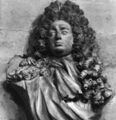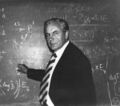Template:Selected anniversaries/June 3: Difference between revisions
No edit summary |
No edit summary |
||
| (6 intermediate revisions by the same user not shown) | |||
| Line 1: | Line 1: | ||
<gallery> | <gallery> | ||
|| *** DONE: Pics *** | |||
||1657: William Harvey dies ... physician and academic ... seminal contributions in anatomy and physiology. He was the first known physician to describe completely, and in detail, the systemic circulation and properties of blood being pumped to the brain and body by the heart, though earlier writers had provided precursors of the theory. Pic. | ||1657: William Harvey dies ... physician and academic ... seminal contributions in anatomy and physiology. He was the first known physician to describe completely, and in detail, the systemic circulation and properties of blood being pumped to the brain and body by the heart, though earlier writers had provided precursors of the theory. Pic. | ||
| Line 17: | Line 19: | ||
||1873: Otto Loewi born ... pharmacologist and psychobiologist, Nobel Prize laureate. Pic. | ||1873: Otto Loewi born ... pharmacologist and psychobiologist, Nobel Prize laureate. Pic. | ||
||1879: Raymond Pearl dies ... biologist and academic ... eugenics, biostatistics. Pic. | |||
||1888: Albert Kluyver born ... microbiologist and biochemist. Kluyver will famously express the ideas of biochemical unity and comparative biochemistry with the aphorism: "From elephant to butyric acid bacterium – it is all the same". Pic. | |||
||1889: The first long-distance electric power transmission line in the United States is completed, running 14 miles (23 km) between a generator at Willamette Falls and downtown Portland, Oregon. | ||1889: The first long-distance electric power transmission line in the United States is completed, running 14 miles (23 km) between a generator at Willamette Falls and downtown Portland, Oregon. | ||
||1899: Georg von Békésy born ... biophysicist and academic, Nobel Prize laureate. Pic. | ||1899: Georg von Békésy born ... biophysicist and academic, Nobel Prize laureate. Pic. | ||
||1900: Adelaide Ames born ... astronomer and academic. Pic search | ||1900: Adelaide Ames born ... astronomer and academic. Pic search. | ||
||1900: Leo Picard born ... geologist and academic. | ||1900: Leo Picard born ... geologist and academic ... expert in the field of hydrogeology. Pic. | ||
||1906: R. G. D. Allen born ... economist, mathematician, and statistician. | ||1906: R. G. D. Allen born ... economist, mathematician, and statistician. Pic. | ||
||1914: Helene | ||1914: Helene Braun born ... mathematician who specialized in number theory and modular forms; proving the convergence of the Eisenstein series. She also wrote an autobiography, ''The Beginning of A Scientific Career'', describing her experience as a female scientist in the Third Reich. Pic. | ||
||1916: The National Defense Act is signed into law, increasing the size of the United States National Guard by 450,000 men. | ||1916: The National Defense Act is signed into law, increasing the size of the United States National Guard by 450,000 men. | ||
| Line 38: | Line 42: | ||
||1925: Camille Flammarion born ... French astronomer and author. Pic (cool associated pics). | ||1925: Camille Flammarion born ... French astronomer and author. Pic (cool associated pics). | ||
||1926: Poet, philosopher, and writer Irwin Allen Ginsberg born. As a Columbia University college student in the 1940s, he began friendships with William S. Burroughs and Jack Kerouac, forming the core of the Beat Generation. He vigorously opposed militarism, economic materialism, and sexual repression, and he embodied various aspects of this counterculture with his views on drugs, hostility to bureaucracy, and openness to Eastern religions. Pic. | |||
||1928: Karl W. Gruenberg born ... mathematician who specialized in group theory, in particular with the cohomology theory of groups. Pic. | ||1928: Karl W. Gruenberg born ... mathematician who specialized in group theory, in particular with the cohomology theory of groups. Pic. | ||
| Line 46: | Line 50: | ||
||1943: In Los Angeles, California, white U.S. Navy sailors and Marines clash with Latino youths in the Zoot Suit Riots. | ||1943: In Los Angeles, California, white U.S. Navy sailors and Marines clash with Latino youths in the Zoot Suit Riots. | ||
||1945: German submarine U-1277 is unusual in so much that it either did not receive Dönitz’s surrender order on 8 May 1945, or chose to ignore it. What is known is that she continued her patrol in the North Atlantic for a further month, her crew finally scuttling her on 3 June 1945 off the northern coast of Portugal. All 47 crew disembarked safely from their sinking boat in rubber dinghies and made their way ashore, landing on the beach at Angeiras, Portugal. There they were interned by the Portuguese authorities, and handed over to a British warship a few days later. The crew were not released from a POW camp until 1947. | |||
||1965: The launch of Gemini 4, the first multi-day space mission by a NASA crew. Ed White, a crew member, performs the first American spacewalk. | ||1965: The launch of Gemini 4, the first multi-day space mission by a NASA crew. Ed White, a crew member, performs the first American spacewalk. | ||
| Line 72: | Line 76: | ||
File:Vladimir Arnold.jpg|link=Vladimir Arnold (nonfiction)|2010: Mathematician and academic [[Vladimir Arnold (nonfiction)|Vladimir Arnold]] dies. He helped develop the Kolmogorov–Arnold–Moser theorem regarding the stability of integrable systems. | File:Vladimir Arnold.jpg|link=Vladimir Arnold (nonfiction)|2010: Mathematician and academic [[Vladimir Arnold (nonfiction)|Vladimir Arnold]] dies. He helped develop the Kolmogorov–Arnold–Moser theorem regarding the stability of integrable systems. | ||
</gallery> | </gallery> | ||
Latest revision as of 18:34, 6 February 2022
1659: Mathematician and astronomer David Gregory born. At the Union of 1707, he bill be given the responsibility of reorganizing the Scottish Mint.
1723: Physician, geologist, and botanist Giovanni Antonio Scopoli born. He will be called the "first anational European" and the "Linnaeus of the Austrian Empire".
1839: In Humen, China, Lin Tse-hsü destroys 1.2 million kg of opium confiscated from British merchants, preliminary to the First Opium War.
1923: Mathematician and dissident Igor Shafarevich born. He will make fundamental contributions to algebraic number theory, algebraic geometry, and arithmetic algebraic geometry.
2009: Arnold's cat map is "better than a laser pointer for keeping a cat amused," says Arnold.
2010: Mathematician and academic Vladimir Arnold dies. He helped develop the Kolmogorov–Arnold–Moser theorem regarding the stability of integrable systems.





